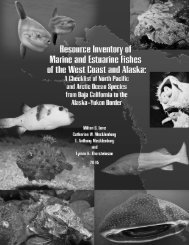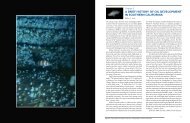Reproductive Ecology and Body Burden of Resident ... - The Love Lab
Reproductive Ecology and Body Burden of Resident ... - The Love Lab
Reproductive Ecology and Body Burden of Resident ... - The Love Lab
Create successful ePaper yourself
Turn your PDF publications into a flip-book with our unique Google optimized e-Paper software.
came from an oil platform (PL4, 3 <strong>of</strong> 8 fish) <strong>and</strong> a natural area (NA4, 9 <strong>of</strong> 10 fish), kelp rockfish came from<br />
an oil platform (PL2, 1 <strong>of</strong> 10 fish) <strong>and</strong> two natural areas (NA3, 8 <strong>of</strong> 10 fish; <strong>and</strong> NA5, 2 <strong>of</strong> 10 fish), <strong>and</strong> Pacific<br />
s<strong>and</strong>dab came from four oil platforms (PL2, 2 <strong>of</strong> 8 fish; PL3, 1 <strong>of</strong> 10 fish; PL4, 3 <strong>of</strong> 10 fish; <strong>and</strong> PL5, 1 <strong>of</strong><br />
10 fish) <strong>and</strong> a natural area (NA3, 3 <strong>of</strong> 10 fish). Although mercury is a potent neurotoxin capable <strong>of</strong> causing<br />
outright mortality in fish <strong>and</strong> wildlife, sublethal effects may include suppression <strong>of</strong> sex hormones, altered<br />
reproductive behavior, <strong>and</strong> impaired reproduction, along with maternal transfer <strong>of</strong> potentially toxic doses<br />
<strong>of</strong> mercury to embryos during oogenesis (Wiener et al. 2003; Scheuhammer et al. 2007).<br />
Selenium concentrations in only two Pacific s<strong>and</strong>dab, both from a natural area (NA2, 2 <strong>of</strong> 10 fish),<br />
equaled or exceeded the toxicity threshold <strong>of</strong> 0.75-1.0 µg Se/g wet weight. According to Maher et al. (1997),<br />
selenium recovered from fish muscle tissues are associated with proteins <strong>and</strong> consist mostly <strong>of</strong> selenocysteine.<br />
Lemly (2002) reported that adverse effects from excessive selenium concentrations in fishes can include<br />
severe tissue pathology, teratogenic deformities, <strong>and</strong> reproductive impairment, along with high mortality.<br />
High concentrations <strong>of</strong> total DDT <strong>and</strong> total PCB have been implicated as the probable cause <strong>of</strong> reproductive<br />
impairment in white croaker (Genyonemus lineatus) sampled from San Pedro Bay in the Southern<br />
California Bight (Schiff et al. 2000). Damage to DNA <strong>and</strong> other subcellular evidence <strong>of</strong> contaminant exposure<br />
in marine fishes have also been associated with high concentrations <strong>of</strong> chlorinated hydrocarbons<br />
(Schiff et al. 2000). However, to our knowledge, no one has linked adverse ecotoxicological responses in<br />
fishes, marine birds, or marine mammals from the Southern California Bight to elevated elemental concentrations<br />
such as those measured during our study.<br />
Relation <strong>of</strong> Elemental Concentrations in Fish to Human Health<br />
<strong>The</strong> USEPA (2000) provided guidance on development <strong>of</strong> risk-based meal consumption limits for<br />
inorganic arsenic, cadmium, methylmercury, selenium, <strong>and</strong> tributyltin in fishes for use in generating fish<br />
consumption advisories (Table 4). However, these consumption limits for humans are based on skinless fillets<br />
(axial muscle tissue), <strong>and</strong> not whole fishes. We estimated fillet concentrations from our data on whole<br />
fishes by using average ratios <strong>of</strong> fillet <strong>and</strong> whole-body concentrations for arsenic, mercury, <strong>and</strong> selenium in<br />
three marine fish species from the Salton Sea in southern California (Saiki 1990). We also estimated fillet<br />
concentrations for cobalt, copper, iron, lead, nickel, vanadium, <strong>and</strong> zinc even though USEPA has not provided<br />
guidance for these elements.<br />
We were unable to find conversion factors for cadmium <strong>and</strong> tin, so we compared USEPA risk-based<br />
meal consumption limits using whole-fish data. <strong>The</strong>se comparisons indicated that cadmium concentrations<br />
in 14 <strong>of</strong> 18 kelp bass, 31 <strong>of</strong> 80 kelp rockfish, <strong>and</strong> 96 <strong>of</strong> 98 Pacific s<strong>and</strong>dab exceeded 0.088 µg Cd/g wet weight,<br />
which indicates that fish consumption should be restricted to 16 or fewer meals per month. Judging from<br />
data for whole fishes (Figure 5), cadmium concentrations in fillets are not expected to differ substantially<br />
between oil platforms <strong>and</strong> natural areas. None <strong>of</strong> the measured concentrations exceeded 5.6 µg Cd/g wet<br />
weight, which corresponds to no consumption <strong>of</strong> fishes. Stapleton (1968) reported that muscle tissue in kelp<br />
bass from the Scattergood Steam Plant in Santa Monica Bay contained average concentrations <strong>of</strong> 3.0-4.0<br />
µg Cd/g dry weight (about 0.75-1.0 µg Cd/g wet weight, assuming 75% moisture), whereas kelp bass from<br />
Catalina Isl<strong>and</strong> contained 2.0-3.0 µg Cd/g dry weight (about 0.50-0.75 µg Cd/g wet weight). Although tin<br />
concentrations in 18 <strong>of</strong> 18 kelp bass, 53 <strong>of</strong> 80 kelp rockfish, <strong>and</strong> 4 <strong>of</strong> 98 Pacific s<strong>and</strong>dab exceeded 0.088 µg<br />
Sn/g wet weight, indicating that fish consumption should be limited to 16 or fewer meals per month, the<br />
risk-based consumption limit was based on highly toxic tributyltin, whereas we measured total tin concentrations<br />
that possibly included relatively non-toxic inorganic tin. We did not attempt to estimate the proportion<br />
<strong>of</strong> tributyltin in our fish samples because it can vary widely in marine fishes (organotins may represent<br />
as little as 3-6% or as much as 18-52% <strong>of</strong> total tin; Eisler 1989).<br />
Arsenic concentrations estimated for fillets were seemingly elevated in fishes sampled from oil platforms<br />
<strong>and</strong> natural areas during our study, with the lowest concentration (0.674 µg As/g wet weight in kelp<br />
25




